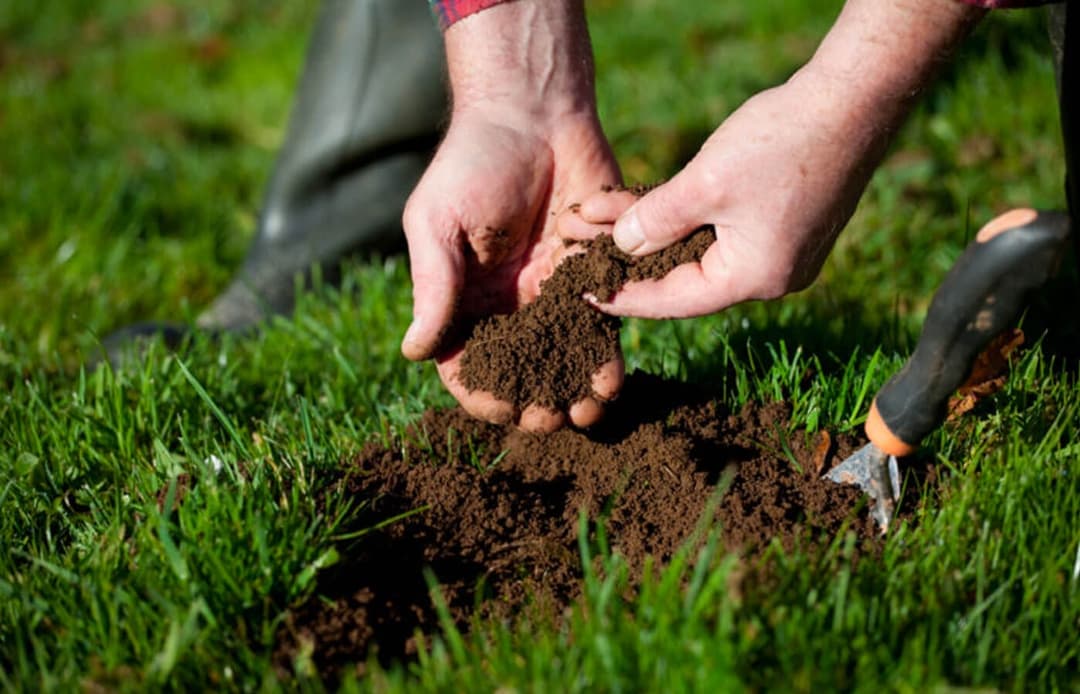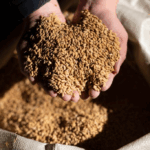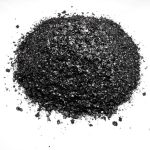What Is Sodium Humate and Why Does It Matter?
Sodium humate is the sodium salt of humic acid, a substance formed when plants, leaves, and other organic matter break down over a long time. It’s dark brown or black, often sold as a powder or granules, and sometimes dissolved in water for liquid applications. It’s like a natural booster shot for soil, helping it hold water, store nutrients, and support the tiny microbes that keep the soil alive. Farmers, gardeners, and even people restoring damaged land use it because it’s a natural way to make soil better without relying on chemical fertilizers.
How Sodium Humate Helps Soil and Plants
Let’s break down the main ways sodium humate works as a soil conditioner. Each of these benefits makes your soil a better home for plants, whether you’re growing vegetables, flowers, or crops like corn or wheat.
- Makes Soil Structure Better
Soil isn’t just dirt—it’s a mix of particles like sand, clay, and organic matter. Sodium humate helps these particles stick together in small clumps, called aggregates. These clumps make the soil looser and less compact, so plant roots can grow more easily. If you’ve got heavy clay soil that feels like concrete when dry, sodium humate can loosen it up, letting air and water move through. If your soil is sandy and falls apart too easily, it helps hold it together, reducing erosion. Better soil structure means happier roots, which leads to stronger, healthier plants. - Holds Onto Nutrients So Plants Can Use Them
Plants need nutrients like nitrogen, phosphorus, and potassium to grow, but these can wash away in rain or irrigation, especially in sandy soils. Sodium humate acts like a sponge, grabbing onto these nutrients and keeping them in the soil where plants can reach them. It’s especially good at “chelating” nutrients, which means it binds them in a way that makes them easier for plants to absorb. This reduces the need for extra fertilizer and saves money while preventing nutrient runoff that can pollute rivers and lakes. - Boosts Soil Microbes
Soil is full of tiny living things—bacteria, fungi, and other microbes—that help break down organic matter and release nutrients for plants. Sodium humate is like a buffet for these microbes, giving them the carbon and energy they need to thrive. When microbes are active, they make the soil more fertile, help plants fight diseases, and even break down harmful substances. A healthy microbial community means your soil is working like a well-oiled machine to support plant growth. - Helps Soil Hold Water
If you’ve ever watered a garden and watched the water disappear into sandy soil, you know how frustrating it can be. Sodium humate improves the soil’s ability to hold water, so plants have a steady supply even during dry spells. This is a game-changer in areas with little rain or for crops that need consistent moisture. By holding water better, sodium humate can reduce how often you need to water, saving time, effort, and resources. - Balances Soil pH
Soil can be too acidic (like lemon juice) or too alkaline (like baking soda), and either extreme can make it hard for plants to get the nutrients they need. Sodium humate acts like a natural balancer, helping to stabilize the soil’s pH. If your soil is too acidic, it can make it less harsh; if it’s too alkaline, it can tone it down. This creates a sweet spot where nutrients are more available to plants, leading to better growth. - Cleans Up Harmful Stuff in Soil
In some cases, soil can contain harmful things like heavy metals (lead, cadmium, etc.) from pollution or overuse of chemicals. Sodium humate can grab onto these toxins and lock them away, so they don’t harm plants or get into the food chain. This makes it a great tool for cleaning up contaminated land, like old industrial sites or over-farmed fields, and turning them back into productive soil. - Reduces Plant Stress
Plants can get stressed just like people—too little water, salty soil, or extreme weather can slow their growth. Sodium humate helps plants cope by improving root development and nutrient uptake, making them more resilient. For example, it can help crops survive drought or salty conditions, which is especially useful in tough climates.
How to Use Sodium Humate
Sodium humate is super versatile, and you can apply it in several ways depending on what you’re growing and what your soil needs. Here’s a rundown of the most common methods:
- Mixing It Into the Soil: You can sprinkle sodium humate powder or granules onto the soil and mix it in before planting. For a small garden, you might use a handful per square meter, while farmers might apply 50 to 200 kilograms per hectare (a hectare is about 2.5 acres). Mix it into the top 10-15 cm of soil for the best effect. This is great for preparing beds for vegetables, flowers, or crops like wheat or soybeans.
- Spraying It on Leaves: You can dissolve sodium humate in water (usually 1-5 grams per liter) and spray it directly onto plant leaves. This is called a foliar spray, and it’s a quick way to give plants a nutrient boost, especially if they’re looking weak or yellow. It’s often used during key growth stages, like when plants are flowering or setting fruit.
- Adding It to Irrigation: If you use drip irrigation or sprinklers, you can mix sodium humate into the water and let it soak into the soil. This is a good option for large fields or greenhouses because it spreads the humate evenly. Use a similar concentration as for foliar sprays, but check your equipment to make sure it won’t clog.
- Soaking Seeds: Before planting, you can soak seeds in a weak sodium humate solution (about 0.5-2 grams per liter) for a few hours. This can help seeds germinate faster and produce stronger seedlings. It’s a simple trick for crops like tomatoes, peppers, or corn.
- Mixing with Compost or Fertilizer: If you make your own compost or use organic fertilizers, adding sodium humate can make them even better. It speeds up composting, adds nutrients, and makes the final product more effective when you spread it on your garden or fields.
Who Can Benefit from Sodium Humate?
Sodium humate is useful for all kinds of people working with soil and plants:
- Farmers: If you’re growing crops like corn, wheat, or rice, sodium humate can increase yields by improving soil health and reducing the need for chemical fertilizers. Studies show it can boost crop yields by 10-20% in some cases, depending on the soil and crop type.
- Gardeners: Whether you’ve got a backyard veggie patch or a flower garden, sodium humate can make your plants healthier and more vibrant. It’s great for roses, tomatoes, or even your lawn.
- Greenhouse Growers: In controlled environments, it helps maximize nutrient use and keeps plants thriving, especially for high-value crops like herbs or orchids.
- Land Restoration Projects: If you’re trying to bring life back to damaged land—like old mining sites or eroded fields—sodium humate can rebuild soil health and help new plants take root.
- Organic Farmers: Since it’s a natural product, sodium humate fits perfectly into organic farming, helping you meet certification standards while improving your soil.
Tips for Getting the Most Out of Sodium Humate
To make sure you’re using sodium humate effectively, keep these tips in mind:
- Test Your Soil First: A soil test can tell you your soil’s pH, nutrient levels, and organic matter content. This helps you figure out how much sodium humate to use and how to apply it. You can get a soil test kit from a garden center or send a sample to a local agricultural extension service.
- Choose a Good Product: Not all sodium humate is the same. Look for products with a high humic acid content (50-70%) and low impurities. Check the label or ask the supplier for details.
- Match It to Your Crop: Different plants have different needs. For example, leafy greens like lettuce might need a foliar spray to boost growth, while root crops like carrots might benefit more from soil application.
- Consider Your Climate: In rainy areas, sodium humate can help keep nutrients from washing away. In dry areas, its water-holding ability is a big plus. Adjust your application based on your local weather and soil type.
- Start Small: If you’re new to sodium humate, try it on a small area first to see how your plants respond. You can always scale up once you’re confident it’s working.
A Real-Life Example
Imagine you’re a farmer growing potatoes on sandy soil that doesn’t hold water or nutrients well. You could mix 100 kg of sodium humate per hectare into the soil before planting to improve its structure and nutrient-holding capacity. During the growing season, you might also use a 0.2% foliar spray (2 grams per liter of water) when the potato plants are starting to form tubers. This could help your potatoes grow bigger and healthier, potentially increasing your yield by 15% or more compared to untreated soil. Plus, you’d likely use less fertilizer and water, saving money and helping the environment.
Things to Watch Out For
While sodium humate is generally safe and easy to use, there are a few things to keep in mind:
- Don’t Overdo It: Using too much can sometimes make the soil too salty, especially in dry climates. Follow recommended rates and check your soil regularly.
- Store It Properly: Keep it in a dry, cool place to prevent it from clumping or losing effectiveness.
- Check Compatibility: If you’re mixing it with other fertilizers or chemicals, make sure they’re compatible. Most organic products work fine, but some chemical sprays might not mix well.
- Be Patient: Sodium humate improves soil gradually. You might not see dramatic results overnight, but over a season or two, your soil and plants will thank you.
Why Sodium Humate Is a Smart Choice
Sodium humate is a natural, sustainable way to improve soil without relying on synthetic chemicals. It’s affordable, easy to use, and works for all kinds of soils and plants. Whether you’re a backyard gardener trying to grow better tomatoes or a farmer aiming for higher yields, sodium humate can make a big difference. It’s also great for the environment, reducing nutrient runoff, supporting soil life, and even helping clean up polluted land.









